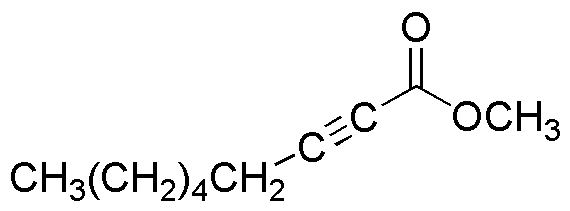Methyl 2-nonynoate is widely utilized in research focused on
- Flavor and Fragrance Industry: This compound is used as a flavoring agent in food products and as a fragrance component in perfumes, providing a fruity and floral aroma that enhances sensory appeal.
- Pharmaceutical Development: Methyl 2-nonynoate serves as an intermediate in the synthesis of various pharmaceuticals, allowing for the creation of complex organic molecules with therapeutic properties.
- Agricultural Applications: It is employed in the formulation of agrochemicals, such as pesticides and herbicides, improving their efficacy and stability in agricultural practices.
- Polymer Production: This chemical is used in the production of specialty polymers and resins, contributing to materials with enhanced durability and performance in industrial applications.
- Research and Development: In academic and industrial laboratories, it is a valuable reagent for organic synthesis, enabling researchers to explore new chemical reactions and develop innovative compounds.
General Information
Properties
Safety and Regulations
Applications
Methyl 2-nonynoate is widely utilized in research focused on
- Flavor and Fragrance Industry: This compound is used as a flavoring agent in food products and as a fragrance component in perfumes, providing a fruity and floral aroma that enhances sensory appeal.
- Pharmaceutical Development: Methyl 2-nonynoate serves as an intermediate in the synthesis of various pharmaceuticals, allowing for the creation of complex organic molecules with therapeutic properties.
- Agricultural Applications: It is employed in the formulation of agrochemicals, such as pesticides and herbicides, improving their efficacy and stability in agricultural practices.
- Polymer Production: This chemical is used in the production of specialty polymers and resins, contributing to materials with enhanced durability and performance in industrial applications.
- Research and Development: In academic and industrial laboratories, it is a valuable reagent for organic synthesis, enabling researchers to explore new chemical reactions and develop innovative compounds.
Documents
Safety Data Sheets (SDS)
The SDS provides comprehensive safety information on handling, storage, and disposal of the product.
Product Specification (PS)
The PS provides a comprehensive breakdown of the product’s properties, including chemical composition, physical state, purity, and storage requirements. It also details acceptable quality ranges and the product's intended applications.
Certificates of Analysis (COA)
Search for Certificates of Analysis (COA) by entering the products Lot Number. Lot and Batch Numbers can be found on a product’s label following the words ‘Lot’ or ‘Batch’.
*Catalog Number
*Lot Number
Certificates Of Origin (COO)
This COO confirms the country where the product was manufactured, and also details the materials and components used in it and whether it is derived from natural, synthetic, or other specific sources. This certificate may be required for customs, trade, and regulatory compliance.
*Catalog Number
*Lot Number
Safety Data Sheets (SDS)
The SDS provides comprehensive safety information on handling, storage, and disposal of the product.
DownloadProduct Specification (PS)
The PS provides a comprehensive breakdown of the product’s properties, including chemical composition, physical state, purity, and storage requirements. It also details acceptable quality ranges and the product's intended applications.
DownloadCertificates of Analysis (COA)
Search for Certificates of Analysis (COA) by entering the products Lot Number. Lot and Batch Numbers can be found on a product’s label following the words ‘Lot’ or ‘Batch’.
*Catalog Number
*Lot Number
Certificates Of Origin (COO)
This COO confirms the country where the product was manufactured, and also details the materials and components used in it and whether it is derived from natural, synthetic, or other specific sources. This certificate may be required for customs, trade, and regulatory compliance.

